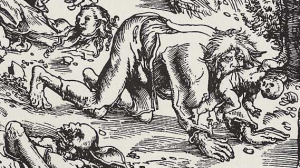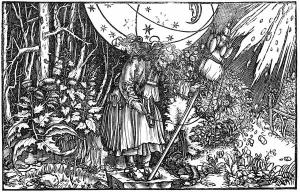It may surprise folks to know just how long the concept of the psychic detective has been around. It did not begin with the “Medium” or Johnny Smith of “The Dead Zone,” or even Douglass Adams’ Dirk Gently. The roots extend back to Sheridan Le Fanu and the 19th century, although the modern concept did not really catch on until Seabury Quinn’s series of Jules de Grandin stories written for Weird Tales in the 20’s and 30’s. However, before de Grandin, there was John Silence, created by Algernon Blackwood (1869-1951), one of the best modern tellers of ghost stories and one of the writers who would inspire H.P. Lovecraft’s concept of cosmic horror with his story “The Willows.”
Blackwood published the John Silence stories in 1908. John Silence is an older, scholarly gentleman with the gift of psychic sensitivities tempered by “training at once physical, mental, and spiritual.” He investigates “psychical disturbances” in individuals, not crimes per se, generally linking them to occult forces and intervening using his own defensive psychic projections or occult ceremonies, making him a sort of metaphysical warrior-poet of sorts. The antagonistic forces are very old-world: psychic possessions by demons and spirits, dealings with witchcraft, lycanthropy, and Egyptian demons. These old-world horrors thrust into the modern setting tend to latch onto dark, hidden passions within the victims creating a sort of synthesis of psychic attack and internal psychological conflict: folk superstition meets modern science. Silence acts always as a force for good, defending the human spirit from oppressive forces both external and internal and attempting to give psychical peace, often at the expense of his own peace. His private secretary, and often the story’s narrator, says of Silence that his power lies in “the knowledge, first, that thought can act at a distance, and, secondly, that thought is dynamic and can accomplish material results.” This concept of the power of human thought as both spiritually linked yet scientifically quantified truly defines the Silence stories as well as the historic context for their creation: the world was very much at a crossroads between the old order and the new day of science and reason. (excerpts from “A Psychical Invasion,” 1908).
The atmosphere of these stories is often rather gothic, utilizing remote locations and family secrets resurfacing from the hidden past. The narrative style varies. One story, for example, is a third-person narrative focused on a character’s encounter with dark forces, and Silence only intervenes at the end. Another is presented as a nightmarish story narrated to Silence. The best stories rely on the Sherlock Holmes model of mystery narration whereby the stories are chronicled in first-person by Silence’s personal secretary, a man experienced enough from working with Silence to adequately tell the story knowledgeably, but being enough of an everyman as to provide an approachable point of view for the reader. In these meta-fictional stories the investigation proceeds slowly, as Silence investigates phenomena and little-by-little determines the origins of the disturbances. Tension mounts as the atmosphere of psychic oppression grows in retaliation to Silences psychic probes. Climaxes are fairly action-packed and suspenseful.
If you enjoy weird fiction, ghost stories, or an alternative kind of early 20th century mystery that isn’t exactly about murder most foul, you should check out John Silence. You can read the stories for free at Project Gutenberg in two volumes: Three John Silence Stories and Three More John Silence Stories
For a little more on the stories check out my reviews below. Another excellent discussion of John Silence can be found at blackgate.com
“A Psychical Invasion” – Dr. John Silence investigates a popular humorist whose good humors are being sapped by a malevolent force lingering in his country lodge. Whose is the sinister face that haunts the humorist’s dreams? Utilizing all his psychic energies with the help of his animal companions, Dr. Silence must banish the sinister presence or die trying.
This is the quintessential Silence story and a good one with which to begin. It features elements of mystery and weird horror fiction. The tension builds slowly towards a psychic showdown in the remote country setting. The best features here are the well-paced rising action as the identity of the evil force is revealed little-by-lttle, and the use of a dog, Flame, and a cat, Smoke, as psychic allies. At first this may sound a bit fantastical, but the treatment of the animals as psychically attuned creatures integral to the investigation is measured and mature. It may well be one of the best “animal stories” around as the animals have true character but never become caricatures of human attributes: the cat is still a cat and behaves as such, as does the dog.
“Ancient Sorceries” – Arthur Venzin, a timid Englishman, is carrying with him the secret of a terrifying encounter in the hill towns of France. He has heard the call of primal spirits and the worship of dark forces in those remote wilds that still hide in even the most civilized countries. Will he be able to purge the dark experience from his psyche with the help of Dr. John Silence, or is it too late? The arcane rites of humanity’s past lurk closer to the surface than any modern man could guess.
“Ancient Sorceries” draws upon a theme recurring in much of Lovecraft’s works as well as the work of other Weird Tales contemporaries: past lives and the calling of the past to the present. A well-read weird fiction connoisseur can often read the doom lurking at the end of the story when this theme arises: man seldom possesses the strength to break the chain of fate forged by the dark, primal forces of the past. This is therefore one of my lesser-preferred stories as it lacks the more intriguing elements that are Silence’s investigations and deductions. Still, “Ancient Sorceries” is worth the read for some of the artfully-wrought grotesque imagery.
“The Nemesis of Fire” – Dr. John Silence’s secretary recounts an investigation that takes he and Silence to the limits of terror as they investigate an ancient presence terrorizing a country estate. A string of mysterious deaths trace their way back to an ill-fated expedition to Egypt. Now Silence will have to use occult rituals to find a name for the force that wishes only to blast the life from those who have disturbed its slumber. Is it too late to stay the flaming sword of vengeance?
This is easily my favorite Silence story. It features the aforementioned narrative style centered around a recounting of the events by Silence’s secretary. It is also the story that has the greatest atmosphere of danger. The climax is both suspenseful and chilling. The forces here are violent and sinister and the mystery plays out subtly. Also there is an adequate mixture of psychic and occult themes.
“The Camp of the Dog” – An English family and some friends take a holiday among the solitary islands of the Swedish Baltic where they set up camp for a secluded, rustic summer retreat. In the loneliness of those still untamed lands, a primal force is calling out to two members of the group, filling itself with their yearning and threatening to swallow their humanity into its pagan maw. Will Dr. Silence and his secretary be able to ward off the spirit of the wilds and stay the destructive hand of a faithless preacher.
This story has the most elements of the aforementioned synthesis of psychic and psychological, and even in the midst of a romance-laden story of werewolves and pagan energies, it seems to comment on the human psyche and the conflict between the passions of the wild untamed world and the constraints of society and civilization. There is a strong subtext of hidden passion suppressed by modern reason. The setting is great for this story: a tiny island accessible only by canoe, several days from mainland. The strange seclusion of the Baltic Islands is a very unique setting, especially for a contemporary reader. The seclusion of the setting, tempered by Blackwood’s flowery descriptions of its severe beauty, and the heightening paranoia that grows as the camping party finds they are not alone on the island makes for a magnificent atmosphere of mystery.
Another intriguing feature of the story in the young female character, Joan Maloney. Typically, one can expect a two dimensional portrayal of women in this type of work, and although Joan does revert to a certain type, she initially has an untamed quality which is portrayed quite positively for a time when manners and conduct were quite restrictive.
“A Victim of Higher Space” – A man so thin he seems to pop in and out of existence–but is it really just a trick or perception or is there something more to his seemingly tenuous grip on this plane of existence. Dr. John Silence must discover how a man can will himself to slip outside of our dimension through only the inadvertent power of a focused mind. However, even if he can discover the secret of this travel, will he be able to anchor him again in this reality?
Although the concepts of this piece of weird fiction are quite gripping and quite probably contribute to the body of work that shaped the mythos of modern horror master H.P. Lovecraft, this story seems to pale in its execution next to the rest of the collection. Our favorite personal secretary is replaced with a newcomer upon whom the story seems to inexplicably center. The new secretary plays into English classicist stereotypes and Blackwood’s use of cockney dialect is tiresome.
That said, there are some quite original concepts here about dimensional existence, the power of thought, tonal vibrations, and the new frontier of experimental mathematics. Any appreciator of weird fiction must surely pause here to admire Blackwood’s execution of the concepts even if the story is less compelling.
“Secret Worship” – An English merchant, Harris, traveling in Germany takes it upon himself to revisit the remote boys school of his childhood. Run by a severe group of Christian Brothers, the school made a lasting impression upon young Harris, who looks back on the order and self-discipline of those days with fondness in the face of a modern world that seems to him more and more hedonistic. However, his journey of reconnection reveals that not all was what it seemed in those days, and a sinister cloud of darkness hovers over the old school buildings. Will Harris be able to escape the darkness that wishes to claim him? Will the mysterious fellow traveler shadowing him be is salvation or his doom.
This story is the most like a traditional weird horror story. The narrative focuses solely on Harris and his gradual discovery of the dark secrets which lurked just out of view in his past. Silence only appears briefly. Tension builds slowly as Harris fills the typical role of the modern everyman who, when faced with the presence of the supernatural, finds every opportunity to reason it away, ignoring each ill-omen. Indeed I found myself wanting to shake some sense into him as he stubbornly continues to descend deeper into danger. The macabre imagery of the damned in this story is excellent: robed, dehumanized monks congregating in an old stone building in the midst of an abandoned village beneath cold stars.






This is a great introduction to the John Silence stories and the occult detective tradition!
I’d be interested to see what you think of my Chronological Bibliography of Early Occult Detectives. I trace this type of character back even earlier than Sheridan Le Fanu. I end with Seabury Quinn’s Jules de Grandin because, as you suggest, something new happened with the introduction of this character.
My list can be found at http://timprasil.wordpress.com/a-chronological-bibliography-of-early-occult-detectives/
That is an excellent chronology you’ve put together and a great resource for writers and researchers of genre fiction.